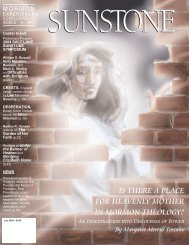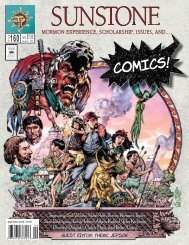Download Entire Issue PDF - Sunstone Magazine
Download Entire Issue PDF - Sunstone Magazine
Download Entire Issue PDF - Sunstone Magazine
Create successful ePaper yourself
Turn your PDF publications into a flip-book with our unique Google optimized e-Paper software.
S U N S T O N E<br />
of the Mormon Non-Mormon Conflict in Hancock County, Illinois,<br />
1839–1846,” Ph.D. dissertation, Brigham Young University, 1967, 43–47;<br />
Andrew F. Smith, Saintly Scoundrel: The Life and Times of Dr. John Cook Bennett<br />
(Urbana: University of Illinois Press, 1997), 58–61.<br />
105. History of the Church, 5: 3–4, 56, 369, 383–84, 6: 34; Hamilton<br />
Gardner, “The Nauvoo Legion, 1840–1845: A Unique Military Organization,”<br />
in Roger D. Launius and John E. Hallwas, eds., Kingdom on the Mississippi<br />
Revisited: Nauvoo in Mormon History (Urbana: University of Illinois Press,<br />
1996), 53 (for lieutenant-general rank), 57 (for “an estimated five thousand<br />
members”); with lower estimates in John Sweeney Jr., “A History of the Nauvoo<br />
Legion In Illinois,” M.A. thesis, Brigham Young University, 1974, 70, 73; compared<br />
with Thomas H.S. Hamersly, Regular Army Register of the United States,<br />
1779–1879 (Washington: By the author, 1880), 84–89.<br />
106. History of the Church, 5: 482.<br />
107. See discussion in narrative-text for Note 124.<br />
108. History of the Church, 1: 434, 3: 81, 204, 328, 5: 15; “Mormons Held<br />
Boggs Responsible For Their Hardships,” in L. Dean Marriott, “Lilburn W.<br />
Boggs: Interaction With Mormons Following Their Expulsion From Missouri,”<br />
Ed.D. dissertation, Brigham Young University, 1979, 27-30.<br />
109. Alanson Ripley to “Dear brethren in Christ Jesus,” with Joseph<br />
Smith, Hyrum Smith, Caleb Baldwin, Alexander McRae, and Lyman Wight<br />
identified by initials at the end of letter, 10 April 1839, Joseph Smith letterbook<br />
2: 17, Smith papers, original in LDS Archives, with microfilm copies at<br />
Community of Christ Archives, at Lee Library, and at Marriott Library; quoted<br />
in Hill, Quest for Refuge, 100.<br />
110. William Clayton diary, 1 January 1845, in George D. Smith, ed., An<br />
Intimate Chronicle: The Journals of William Clayton (Salt Lake City: Signature<br />
Books/Smith Research Associates, 1991), 153, gives the earliest available statement<br />
of the revelation’s text but does not date it. The earliest known statement<br />
that this revelation occurred on 7 April 1842 is Council of Fifty minutes, 10<br />
April 1880, typed copy, Lee Library, also in Joseph F. Smith diary, 10 April 1880,<br />
LDS Archives (with complete transcription in Quinn’s research files, Beinecke<br />
Library), and in Andrew F. Ehat, “`It Seems Like Heaven Began on Earth’:<br />
Joseph Smith and the Constitution of the Kingdom of God,” BYU Studies 20<br />
(Spring 1980): 254n3. Restatements and slight variations of this council’s long<br />
name (given by the 1842 revelation) appear in Kenney, Wilford Woodruff’s<br />
Journal: 1833–1898 Typescript, 3 (29 May 1847): 188; John D. Lee diary, 3<br />
March 1849, in Robert Glass Cleland and Juanita Brooks, eds., A Mormon<br />
Chronicle: The Diaries of John D. Lee, 1848–1876, 2 vols. (San Marino, CA: The<br />
Henry E. Huntington Library, 1955), 1: 98; Joseph F. Smith diary, 16 March<br />
1880; Franklin D. Richards diary, 16 March 1880, LDS Archives, Council of<br />
Fifty minutes, 10 April 1880, LDS Archives, Joseph F. Smith memorandum, 31<br />
December 1880, LDS Archives (with complete transcriptions of the above in<br />
Quinn’s research files, Beinecke Library); Abraham H. Cannon diary, 9 October<br />
1884, Lee Library, Marriott Library, and Utah State Historical Society; John<br />
Taylor revelation of 27 June 1882, in Annie Taylor Hyde notebook, 67, LDS<br />
Archives, with complete transcription in Quinn’s research files, Beinecke<br />
Library; and in Fred C. Collier, Unpublished Revelations of the Prophets and<br />
Presidents of The Church of Jesus Christ of Latter-day Saints, 2nd ed. (Salt Lake<br />
City: Collier’s Publishing Co., 1981), 134, verse 29.<br />
111. The Wasp (Nauvoo, IL), 28 May 1842.<br />
112. William Law statement, 31 July 1887, in Lyndon W. Cook, ed.,<br />
William Law: Biographical Essay, Nauvoo Diary, Correspondence (Orem, UT:<br />
Grandin Book Co., 1994), 116–17.<br />
113. Jonas Hobart affidavit on 9 July 1842 (for quote); Samuel Marshall<br />
affidavit on 9 July 1842 (for third person paraphrase of quote), both in John C.<br />
Bennett, The History of the Saints . . . (Boston: Leland and Whiting, 1842), 285.<br />
Lacking the effusiveness and sensationalism that Bennett and his allies typically<br />
used, these affidavits quoted/paraphrased Rockwell’s guarded and not-quite-incriminating<br />
statement. Under the circumstances, the affidavits sound like unexaggerated<br />
statements of what Hobart and Marshall actually heard him say.<br />
114. Quoted in Harold Schindler, Orrin Porter Rockwell: Man of God, Son<br />
of Thunder (Salt Lake City: University of Utah Press, 1966), 80.<br />
115. William M. Boggs, “A Short Biographical Sketch of Lilburn W.<br />
Boggs, By His Son,” Missouri Historical Review 4 (January 1910): 107; also<br />
Nicholas Van Alfen, Orrin Porter Rockwell: The Frontier Mormon Marshal<br />
(Logan, UT: LDS Institute of Religion, 1964), 20–32; Monte B. McLaws, “The<br />
Attempted Assassination of Missouri’s Ex-Governor, Lilburn W. Boggs,”<br />
Missouri Historical Review 60 (October 1965): 50–62; Flanders, Nauvoo,<br />
104–05; Schindler, Orrin Porter Rockwell, 74–109; Richard Lloyd Dewey, Porter<br />
Rockwell: The Definitive Biography (New York: Paramount Books, 1986), 49–77.<br />
116. Joseph Smith letter to Mr. Bartlett, 22 May 1842, in Quincy Whig<br />
(Quincy, IL), 4 June 1842; Joseph Smith letter to the editor, 27 May 1842, in<br />
Quincy Herald (Quincy, IL), 2 June 1842; History of the Church, 5: 9, 15, 6: 151.<br />
117. History of the Church, 5: 4, 13; Book of the Law of the Lord, 19 May<br />
1842, in Jessee, Papers of Joseph Smith, 2: 384; The Wasp (Nauvoo, IL), 21 May<br />
1842, [3], 4 June 1842, [3]. The Night Watch in 1842 included Dimick B.<br />
Huntington, William D. Huntington, Lucius N. Scovil, Charles Allen, Albert P.<br />
Rockwood, Noah Rogers, Shadrach Roundy, Josiah Arnold, David H. Redfield,<br />
Hiram Clark, S.B. Hicks, Erastus H. Derby, John A. Forgeus, Gilbert D.<br />
Goldsmith, Daniel Carn, and John G. Luce. See appendix, “Danites in 1838: A<br />
Partial List,” in Origins of Power, [479]–490.<br />
118. History of the Church, 5: 4.<br />
119. James B. Allen, Trials of Discipleship: The Story of William Clayton, A<br />
Mormon (Urbana: University of Illinois Press, 1987), 140. Based on the list of<br />
Smith’s personal staff and “guards” in the Nauvoo Legion as of February 1841<br />
(History of the Church, 4: 296), Hartley, My Best For the Kingdom, 120, lists as<br />
Smith’s twelve bodyguards the following men: John L. Butler, Thomas Grover,<br />
Christian M. Kremeyer, John Snyder, Alpheus Cutler, Reynolds Cahoon, Henry<br />
G. Sherwood, Shadrach Roundy, Vinson Knight, James Allred, Elias Higbee,<br />
and Samuel H. Smith. A problem with this list is that it omits Orrin Porter<br />
Rockwell, widely known as one of Smith’s bodyguards. Hartley also omits<br />
Albert P. Rockwood, the actual commander of the “lifeguards,” with the explanation<br />
that the 1841 entry in History of the Church listed Rockwood only as a<br />
“drill master” with the Nauvoo Legion. Apparently, Smith’s “lifeguards” in the<br />
Nauvoo Legion were for ceremonial purposes and overlapped with his actual<br />
bodyguards who were “ordained” to protect his life. For sources about the<br />
Danite affiliation of the above men, see appendix, “Danites in 1838: A Partial<br />
List,” in Origins of Power, [479]–490.<br />
120. L.B. Fleak (at Keokuk, Iowa) to Governor Thomas Reynolds, 4<br />
December 1842, folder 14346, box 319, Reynolds Correspondence, Missouri<br />
State Archives, Joseph City, Missouri, with transcription in Warren A. Jennings,<br />
“Two Iowa Postmasters View Nauvoo: Anti-Mormon Letters to the Governor of<br />
Missouri,” BYU Studies 11 (Spring 1971): 286. For the context of why<br />
Missouri’s governor was receiving reports from attempted kidnappers, see<br />
George R. Gayler, “Attempts by the State of Missouri to Extradite Joseph Smith,<br />
1841–1843,” Missouri Historical Review 58 (October 1963): 21–36.<br />
121. Joseph Smith diary, 1 January 1843, in Faulring, An American<br />
Prophet’s Record, 267; History of the Church, 5: 216, deleted this entry; see Note<br />
26, last sentence.<br />
122. History of the Church, 5: 285.<br />
123. History of the Church, 5: 316.<br />
124. Joseph Smith diary, 5 March 1843, in Faulring, An American<br />
Prophet’s Record, 326; phrased differently in History of the Church, 5: 296 (“I will<br />
shoot him, or cut off his head, spill his blood on the ground,” also “on that subject”);<br />
see Note 26, last sentence.<br />
The LDS Church’s official history changed the phrase to “cut off his head”<br />
as an apparent effort to make readers think the founding prophet was referring<br />
to the civil execution by decapitation as practiced in the decades-earlier French<br />
Revolution. However, Smith’s actual phrase “cut his throat” replayed the throatcutting<br />
threats by Missouri Danites (including Sidney Rigdon) in 1838 (see<br />
quotes for previous notes 82 and 83). The LDS prophet’s 1843 statement was<br />
also an official precedent for Counselor Rigdon’s throat-slitting statement to<br />
April 1844 general conference (see quote in narrative for Note 149).<br />
Smith’s 1843 statement was also an obvious precedent for Brigham Young’s<br />
similar phrases in his published sermons about “blood atonement” during the<br />
1850s (see Note 152). Published in Salt Lake City, the LDS Church’s official<br />
History of the Church, 5: 296 even described Smith’s remarks as “The Questions<br />
of `Currency’ and Blood Atonement, in the Nauvoo City Council.” Notice that<br />
its editors did not put quotation marks around Blood Atonement, but did for<br />
“Currency.”<br />
125. Joseph Smith statement, manuscript minutes of 6 April 1843 conference,<br />
first version (page 10), and with quoted words lined out in second version<br />
(page 4), both documents in LDS Archives, with complete transcriptions<br />
in Quinn’s research files, Beinecke Library. This statement by Joseph Smith is<br />
absent from the report of his remarks in Times and Seasons, History of the<br />
Church, and in Andrew F. Ehat and Lyndon W. Cook, eds., The Words of Joseph<br />
Smith: The Contemporary Accounts of the Nauvoo Discourses of the Prophet Joseph<br />
(Provo, UT: Religious Studies Center, Brigham Young University, 1980),<br />
173–81.<br />
126. John L. Butler reminiscence, in Journal History, 6 August 1838,<br />
page 6.<br />
OCTOBER 2011 PAGE 35

















